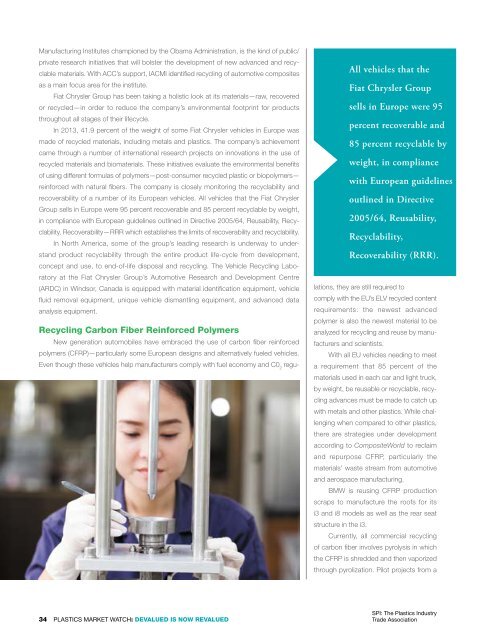Recycling Devalued is now Revalued
1SPybsx
1SPybsx
Create successful ePaper yourself
Turn your PDF publications into a flip-book with our unique Google optimized e-Paper software.
Manufacturing Institutes championed by the Obama Admin<strong>is</strong>tration, <strong>is</strong> the kind of public/<br />
private research initiatives that will bolster the development of new advanced and recyclable<br />
materials. With ACC’s support, IACMI identified recycling of automotive composites<br />
as a main focus area for the institute.<br />
Fiat Chrysler Group has been taking a hol<strong>is</strong>tic look at its materials—raw, recovered<br />
or recycled—in order to reduce the company’s environmental footprint for products<br />
throughout all stages of their lifecycle.<br />
In 2013, 41.9 percent of the weight of some Fiat Chrysler vehicles in Europe was<br />
made of recycled materials, including metals and plastics. The company’s achievement<br />
came through a number of international research projects on innovations in the use of<br />
recycled materials and biomaterials. These initiatives evaluate the environmental benefits<br />
of using different formulas of polymers—post-consumer recycled plastic or biopolymers—<br />
reinforced with natural fibers. The company <strong>is</strong> closely monitoring the recyclability and<br />
recoverability of a number of its European vehicles. All vehicles that the Fiat Chrysler<br />
Group sells in Europe were 95 percent recoverable and 85 percent recyclable by weight,<br />
in compliance with European guidelines outlined in Directive 2005/64, Reusability, Recyclability,<br />
Recoverability—RRR which establ<strong>is</strong>hes the limits of recoverability and recyclability.<br />
In North America, some of the group’s leading research <strong>is</strong> underway to understand<br />
product recyclability through the entire product life-cycle from development,<br />
concept and use, to end-of-life d<strong>is</strong>posal and recycling. The Vehicle <strong>Recycling</strong> Laboratory<br />
at the Fiat Chrysler Group’s Automotive Research and Development Centre<br />
(ARDC) in Windsor, Canada <strong>is</strong> equipped with material identification equipment, vehicle<br />
fluid removal equipment, unique vehicle d<strong>is</strong>mantling equipment, and advanced data<br />
analys<strong>is</strong> equipment.<br />
<strong>Recycling</strong> Carbon Fiber Reinforced Polymers<br />
All vehicles that the<br />
Fiat Chrysler Group<br />
sells in Europe were 95<br />
percent recoverable and<br />
85 percent recyclable by<br />
weight, in compliance<br />
with European guidelines<br />
outlined in Directive<br />
2005/64, Reusability,<br />
Recyclability,<br />
Recoverability (RRR).<br />
New generation automobiles have embraced the use of carbon fiber reinforced<br />
polymers (CFRP)—particularly some European designs and alternatively fueled vehicles.<br />
Even though these vehicles help manufacturers comply with fuel economy and C0 2<br />
regulations,<br />
they are still required to<br />
comply with the EU’s ELV recycled content<br />
requirements: the newest advanced<br />
polymer <strong>is</strong> also the newest material to be<br />
analyzed for recycling and reuse by manufacturers<br />
and scient<strong>is</strong>ts.<br />
With all EU vehicles needing to meet<br />
a requirement that 85 percent of the<br />
materials used in each car and light truck,<br />
by weight, be reusable or recyclable, recycling<br />
advances must be made to catch up<br />
with metals and other plastics. While challenging<br />
when compared to other plastics,<br />
there are strategies under development<br />
according to CompositeWorld to reclaim<br />
and repurpose CFRP, particularly the<br />
materials’ waste stream from automotive<br />
and aerospace manufacturing.<br />
BMW <strong>is</strong> reusing CFRP production<br />
scraps to manufacture the roofs for its<br />
i3 and i8 models as well as the rear seat<br />
structure in the i3.<br />
Currently, all commercial recycling<br />
of carbon fiber involves pyrolys<strong>is</strong> in which<br />
the CFRP <strong>is</strong> shredded and then vaporized<br />
through pyrolization. Pilot projects from a<br />
34 PLASTICS MARKET WATCH: DEVALUED IS NOW REVALUED<br />
SPI: The Plastics Industry<br />
Trade Association


